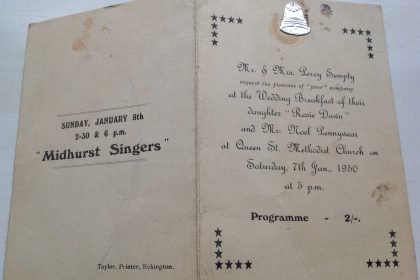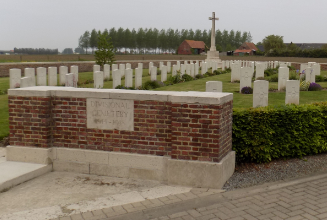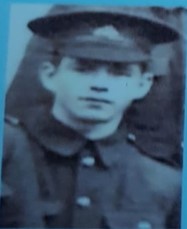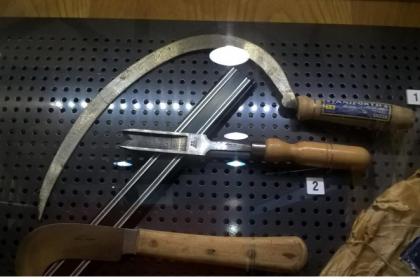Standing here at the bus-stop, I see opposite me a very new building named “Mosshouse”. To the left of it are renovated stone buildings which look very smart and attractive. I can remember we lived in a small cottage which was attached to the building still standing there. We spent the first eight years of our married life there in the “Blacksmith’s yard – or as it sometimes called “Drabbles’ Yard”.
The yard is very quiet now but in those days it was a hive of activity with lorries belonging to “Drabble and Sons” coming in and out all day, and the whining of the electric saws in the joiner’s shop which was round the side, only a small distance behind our cottage.
The shouting of the workmen and their bosses, the clanging and banging of equipment and tools being loaded into the lorries gradually died away after eight o’ clock. Then we heard the massive shoeing shop doors being opened and fastened back and the sound of the smaller door of the blacksmith’s workshop being opened. ‘Reg’ had arrived to commence his work for the day.
By that time, I had begun my work for the day in the cottage, which was very small. It had only one room downstairs with a small sash window, underneath which was a sink a shallow stone one, with one cold water tap.
For heating and cooking there was an impressive, black, iron and steel “Yorkshire Range”. It was very efficient for baking, cooking and keeping food dishes warm. On the left-hand side of the fire there was a small water-boiler. This was our only source of hot water except for the large smoke-covered, black iron kettle. Fixed around the fire was a very large fireguard, which on wet washing day I found very handy.
In the wall opposite the door and window were two more doors. The one immediately opposite the outside door opened into a pantry, which extended under the stairs, the other one opening onto the bottom of the stairs, the first few steps of which were very narrow and curved. This door was very low, and we often banged our heads on the oak beams in the ceiling. At the top of the stairs we stepped immediately onto the cold, cement floor of the low-ceilinged bedroom illuminated by two tiny, sliding, sash windows, one situated at the front and one at the back.
We could sit very comfortably in the recesses under the windows as they were two feet in depth. Inserted in one wall was a much smaller version of the fireplace downstairs which we found very cosy in the winter – because that bedroom was freezing cold.
By the time we vacated that tiny cottage the bedroom had to contain a double bed, a three quarter size bed, a baby’s cot, a dressing table, a large wardrobe and a gent’s wardrobe, so maybe you will have guessed! – we were classed as overcrowded. Thinking back, I wonder how I ever managed to cope with so small a space during the birth of my three sons in that bedroom. Housework was hard then.
There were no washing machines, electric cleaners, fridges or television sets as the period was nineteen forty to nineteen forty-eight, the war years – a really austere time!
Our only musical entertainment was a wireless set, which I remember was powered by low and high tension batteries and an accumulator which had to be charged frequently.
This cost us five hold pennies. We did have electricity in the cottage but we couldn’t afford a ‘modern radio’.
Having moved into our new three bedroomed council house containing all the ‘mod-cons’ we began to miss my husbands’ parents and sister, who lived in the house next door to the cottage. Part of this house is still standing alongside the renovated blacksmith’s premises. It was much larger that the cottage we had lived in, and contained three large bedrooms, two large bedrooms downstairs, and a very large pantry which was well- equipped with shelves.
I can’t possibly hope to do justice to the description of my mother-in-law! She was sixty-three years of age, of medium height with slightly stooping shoulders. She had raven black hair, dark brown twinkling eyes and a gentle winning smile, – I loved her very much. She was the sweetest, kindest, most tactful and gentle person I have ever known – I shall never forget her! She spoke very quietly, giving advice whenever it was needed – but never interfering!
She was also an expert at pouring oil on troubled waters. I often wonder where she got her inner strength from, because she had had a hard life. She had borne seventeen children, nine of whom had survived. Anyone who had known Sarah-Ann would wholly agree with me.
In addition to carrying out her daily chores she operated a small business selling: vinegar, paraffins, bundles of sticks, matches, candles, firelighters, household soap, soda and various other items including black-lead and donkey stones. The latter item was used to whiten the steps, windowsills and the raised edges of the stone sinks. Friday was a regular day for swilling the yard, cleaning windows, whitening the steps, the windowsills and the surrounds of the grates. We were very meticulous about our fancy patterns – we were very meticulous about our fancy patterns – woe betide anyone who dared to step on them before the dried! Sarah-Ann also mashed the tea for the joiners and their apprentices, who brought their cans to the house at lunch time along with their tins containing tea and sugar. These had a division across the centre which kept the tea separate from the sugar. She provided the fresh milk for which they paid a penny each.
My father-in-law, Albert, was a big, strong man who worked at Beighton Colliery and ruled the roost with a rod of iron. On the ground, which is now a car park, he kept: – pigs, rabbits, chickens and geese, these were very useful for supplementing the rationing of the war years. In the garden there grew three pear trees, four apples trees, a quantity of fruit bushes and a fine row of rhubarb. We always made good use of the harvest from the garden and the excess was sold to willing buyers. Albert was frequently asked to assist Reg in the yard, especially when a cartwheel needed a new rim.
The blacksmiths was not unlike “Aladdin’s Cave!”. It was festooned with various items of his trade too numerous to mention. The colours leaping out of the fire when he pumped air through with his bellows sparkled like precious gems glowing in the air. As he rhythmically tapped the horseshoes into shape on his solid iron anvil, the sparks flying in all directions appeared like dancing diamonds.
Reg was a stocky man with powerful muscles. He wore a strong, leather apron which was split up the centre up the centre and shone like glass from the natural oils deposited from the horses’ skins. He was a staunch Methodist and we never heard him swear. He had an instinct with the horses and knew exactly when they were about to lash out with their feet. When we had any time to spare, we delighted in leaning over the bottom half of the Dutch door to watch him expertly tapping out the horseshoes with a tong – tong, ting, ting, – it never varied.
The two large doors at the top of the yard were fastened back all day to allow the farmers to lead their horses inside and secure their reins to strong, iron rings which were set in the walls. There was only one item in this shoeing shop. It was a three-legged, iron stand about two feet six inches in height, the legs of which joined together at the top to form a small, round iron disc. Reg placed the horses’ feet on this contraption while he filed the horses’ hooves after he had reshod them.
I’m sure we all liked the shire horses best. They were impressive creatures with their shaggy manes and feathered feet. Of all the horses which came into the yard, these were the most magnificent and above all, the most gentlest.
What a pity that this ancient craft has now gone, forever, from the village of Mosborough.
Thanks to Derek Brunt for letting me type up Edith Brunt’s memories. (Linda Taylor nee Staton)








